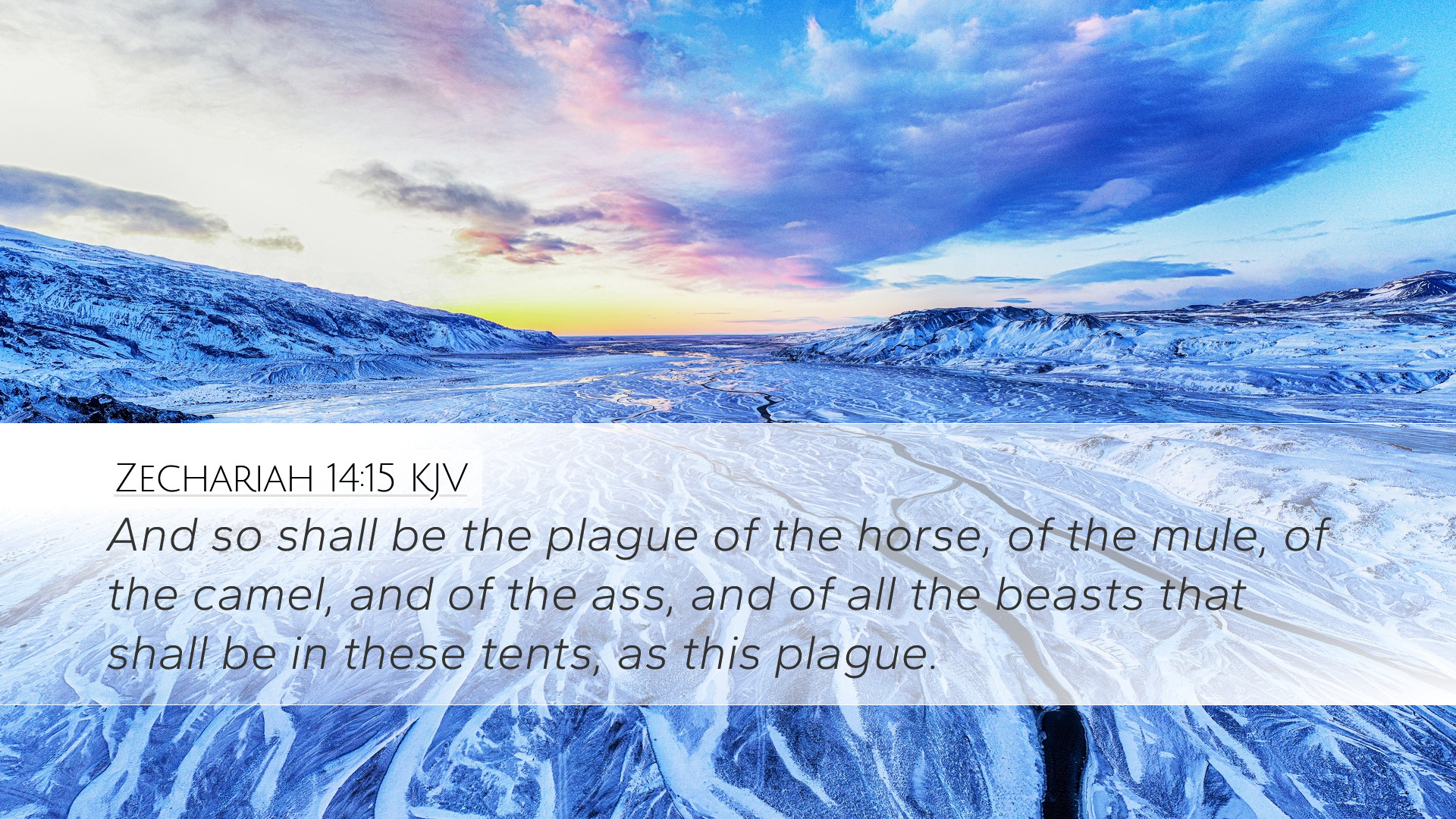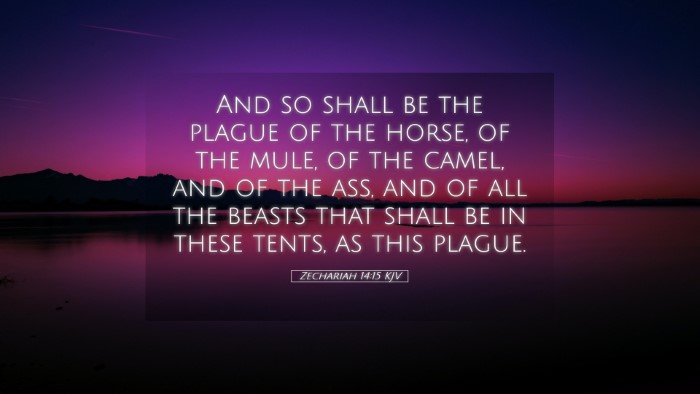Commentary on Zechariah 14:15
Verse Text: "And so shall be the plague of the horse, of the mule, of the camel, and of the ass, and of all the beasts that shall be in these tents, as this plague." (Zechariah 14:15)
Introduction
Zechariah 14:15 presents a prophetic vision steeped in symbolic imagery, offering profound implications for theological reflection and understanding. Its placement within the context of the prophetic literature of Zechariah, particularly the eschatological themes, sets the stage for deeper exploration into God’s judgment and the ultimate victory of His kingdom.
Contextual Background
The Book of Zechariah encompasses a series of prophecies that speak to the restoration of Israel and the coming of the Lord. This chapter, specifically, describes a future day of the Lord when nations will gather against Jerusalem. In this apocalyptic setting, Zechariah highlights the spiritual and physical realities that will accompany divine intervention.
Interpretation of the Plague
The verse speaks of a plague affecting various animals. This imagery represents both the actual devastation that will accompany divine judgment and a metaphor for the totality of God's judgment on those who oppose Him. The reference to specific animals—the horse, mule, camel, and donkey—suggests a comprehensive impact on both the agricultural and military aspects of society:
- The Horse: Often associated with war, the horse symbolizes military might. Its inclusion indicates the futility of human strength against divine power.
- The Mule: A symbol of burden-bearing, the mule represents labor and the common people, stressing that judgment impacts all levels of society.
- The Camel: Seen as a means of transport, the camel might signify trade and commerce, implying economic disruption.
- The Donkey (Ass): Typically humble, the donkey might represent the poor and those of lowly status, affirming that all of creation stands affected by this plague.
Theological Reflections
Theologically, this verse allows for a multi-faceted exploration of God’s sovereignty and judgment. The concept of a plague can be revisited through:
- God’s Sovereignty: This verse affirmatively declares that all creation is under God's authority, thus no one can escape the implications of His decree, whether animal or human.
- Judgment and Mercy: It serves to highlight the seriousness of sin and rebellion against God. Yet, simultaneously, it hints at God’s mercy in the midst of judgment through the prospect of restoration that follows.
- Sign of Universal Accountability: The inclusion of various beasts indicates that all parts of life—military, economic, and social—are accountable to God, thereby influencing various spheres of human activity.
Connections to New Testament Themes
One cannot overlook the connections to New Testament themes, particularly regarding the final judgment and the establishment of God’s kingdom. The image of plague in Zechariah connects to Revelation, where similar apocalyptic imagery unfolds with clear divine retribution and delineates the fate of the wicked. It accentuates the continuity of God’s redemptive history, culminating in the return of Christ and the restoration of creation.
Commentary Insights from Historical Figures
Matthew Henry emphasizes the sheer power of God's judgment, suggesting that it renders human efforts and boasts meaningless in light of divine authority. He notes that those who do not align with God's will face severe consequences, which is a theme echoed throughout his works—underscoring the gravity of disobedience in the face of God’s unconditional love.
Albert Barnes sees this plague as a literal event that signifies the overthrow of enemies, suggesting it stands not only as metaphoric for divine wrath but also as assurance for believers in the ultimate triumph of God's people over adversity, supporting their hope for vindication.
Adam Clarke focuses on the spiritual significance of the beasts mentioned, interpreting the plague as indicative of the moral and spiritual decline resulting from sin. He challenges readers to reflect on the spiritual health of their community in relation to the divine standards set forth in Scripture.
Conclusion
Zechariah 14:15 serves as a powerful reminder of God’s inescapable judgment and the assurance of His sovereignty over all creation. As theologians, pastors, and students delve into its implications, they should find in this text a call to reflect on the seriousness of sin and the great hope in redemption that lies within God’s overarching plan for humanity. By understanding both the immediate and eschatological implications of this prophetic word, believers are equipped to live in the light of God's ultimate triumph over sin and evil.


